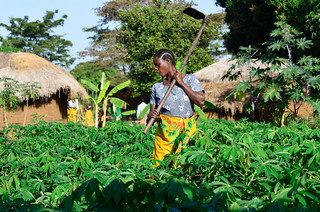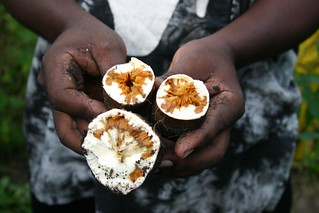
The Cassava Brown Streak Disease (CBSD) is rapidly spreading  westwards in Africa, causing massive losses to farmers in its wake. Experts are reporting new outbreaks and the increased spread of CBSD in the Democratic Republic of the Congo—the world’s third largest cassava producer—and Angola, where production has boomed in recent years.The rapidly proliferating plant virus could cause a 50 percent drop in production of a crop that provides a significant source of food and income for 300 million Africans. Its potential arrival in Nigeria, the largest cassava producer in the world, could result in drastic food shortages.
westwards in Africa, causing massive losses to farmers in its wake. Experts are reporting new outbreaks and the increased spread of CBSD in the Democratic Republic of the Congo—the world’s third largest cassava producer—and Angola, where production has boomed in recent years.The rapidly proliferating plant virus could cause a 50 percent drop in production of a crop that provides a significant source of food and income for 300 million Africans. Its potential arrival in Nigeria, the largest cassava producer in the world, could result in drastic food shortages.
The “pandemic” of CBSD is particularly worrisome as agriculture experts have been looking to the otherwise-resilient cassava plant as the perfect crop for boosting food security in a continent where agricultural conditions in many regions are deteriorating in the face of climate change. Cassava has been championed as the “Rambo root” for its extraordinary ability to survive extreme temperatures and tolerate poor soils, if its susceptibility to pest and disease outbreaks can be effectively tackled. New varieties released in recent months and years, and some still under development, address some of its nutritional and physiological shortcomings, and could transform cassava into an African cash crop with a versatile role to play in development.
“Cassava is already incredibly important for Africa and is poised to play an even bigger role in the future, which is why we need to move quickly to contain and eliminate this plague,” says Claude Fauquet, a scientist at the International Center for Tropical Agriculture (CIAT) headquartered in Colombia who heads the Global Cassava Partnership for the 21st Century (GCP21). “We are particularly concerned that the disease could spread to West Africa and particularly Nigeria—the world’s largest producer and consumer of cassava—because Nigeria would provide a gateway for an invasion of West Africa where about 150 million people depend on the crop.”
GCP2 is an alliance of the world’s leading cassava scientists, donors and private industry. They are gathered at the Rockefeller Foundation Bellagio Center in Italy this week for a conference dedicated to Declaring war on cassava viruses in Africa, with a view to accelerating research into long-lasting solutions to viral cassava diseases. Such solutions include selective breeding to develop cassava varieties with greater disease resistance, and working with scientists in South America, where cassava originated,to mine the cassava gene bank at CIAT to find and develop genetically superior cassava plants that are completely resistant to CBSD and other diseases.The CIAT Genebank is the biggest repository of cassava samples in the world.
Firs t identified in 1935 in East Africa but little-known until just about ten years ago, CBSD has emerged as the most dangerous of all cassava viruses. Infections can destroy up to 100 percent of a farmer’s harvest without the farmer’s knowledge. The unseen killer consumes the cassava roots while they are still in the ground, without producing visible symptoms in the rest of the plant. Only at harvest do farmers discover the blighted, inedible roots which, when cut open, reveal trademark brown blotches of destroyed flesh that give the disease its name.
t identified in 1935 in East Africa but little-known until just about ten years ago, CBSD has emerged as the most dangerous of all cassava viruses. Infections can destroy up to 100 percent of a farmer’s harvest without the farmer’s knowledge. The unseen killer consumes the cassava roots while they are still in the ground, without producing visible symptoms in the rest of the plant. Only at harvest do farmers discover the blighted, inedible roots which, when cut open, reveal trademark brown blotches of destroyed flesh that give the disease its name.
Scientists have attributed the sudden boom in CBSD to an explosion in the numbers the whitefly – insects that carry the pathogen and infect the cassava plants while feeding on the sap. Whitefly populations in Africa have grown exponentially in recent years - a phenomenon which scientists have linked to rising temperatures that create more favourable breeding conditions for the persistent pest.
“We used to see only three or four whiteflies per plant; now we’re seeing thousands,”  said Dr James Legg, a cassava expert at the International Institute of Tropical Agriculture (IITA) headquartered in Ibadan, Nigeria; “You literally have a situation where human beings are competing for food – with flies,” he adds.
said Dr James Legg, a cassava expert at the International Institute of Tropical Agriculture (IITA) headquartered in Ibadan, Nigeria; “You literally have a situation where human beings are competing for food – with flies,” he adds.
The spread of the disease can be accelerated by humans too – through the movement and planting of infected stem cuttings, the most common way to propagate cassava. Scientists note it would take several years for the disease to spread across the continent via whiteflies alone, the movement of cassava cuttings could spark outbreaks in new areas overnight.
The GCP21 Conference participants will discuss development of a regional strategy to gradually, village by village, replace farmers’ existing infested cassava plants with virus-free, resistant varieties, as well as ways of controlling whiteflies that are cost effective and environmentally sustainable. They will also consider the need for new research into the potential threat African cassava producers face from the introduction of new pests and diseases from elsewhere.
“It’s time for the world to recalibrate its scientific priorities,” asserts Dr Fauquet. “Cassava has the greatest potential to reduce hunger and poverty in Africa – more than any other crop – but these diseases are crippling yields and destroying this potential. We need to treat CBSD and other destructive viruses like the smallpox of cassava – formidable diseases, but threats we can eradicate if everyone pulls together.”
“It’s a tale of two continents,” said CIAT’s Agrobiodiversity Research Area director Joe Tohme, who jointly co-ordinates GCP21. “We’ve seen in the very recent past the devastation caused when cassava pests ‘jump’ from Latin America to Africa, so we need to be realistic and plan for the inevitability of outbreaks of new diseases in Africa by developing plants resistant to frog skin disease, for example, a major viral disease of cassava in South America which, luckily, is not present in Africa. Past events show very clearly that even though these two continents are far apart, cassava pests and diseases will somehow, eventually, find a way of getting from one to the other.”
Besides being a staple for over 300 million people on the continent, cassava is also used to produce starch, flour, biofuel and even beer.Nigeria now produces 50 million tons annually and has bet big on cassava for its agricultural and industrial development .Nigeria is the first African country to massively invest in the potential of cassava to meet the rapidly growing global demand for industrial starches, which are used in everything from food products to textiles, plywood and paper. Nigeria hopes to mimic the success of countries in Southeast Asia, where a cassava-driven starch industry now generates US$5 billion per year and employs millions of smallholder farmers and numerous small-scale processors.
This article is adapted from a piece published in the CIAT website by on 6th May 2013; and a press release from the GCP21 conference at the Rockefeller Foundation Bellagio Center in Italy